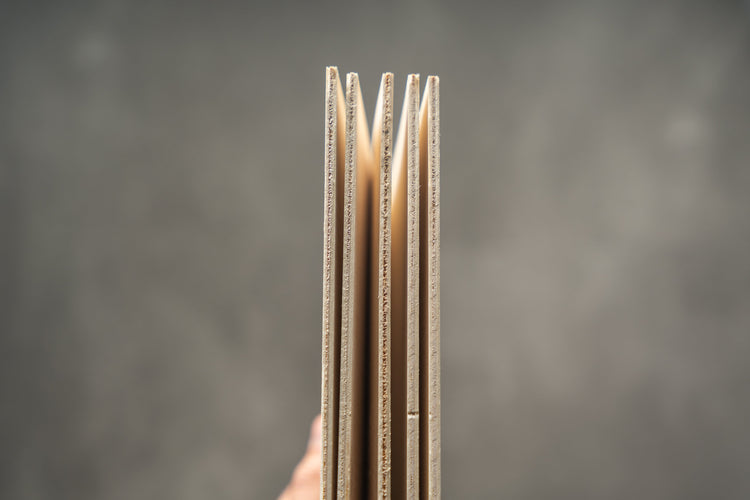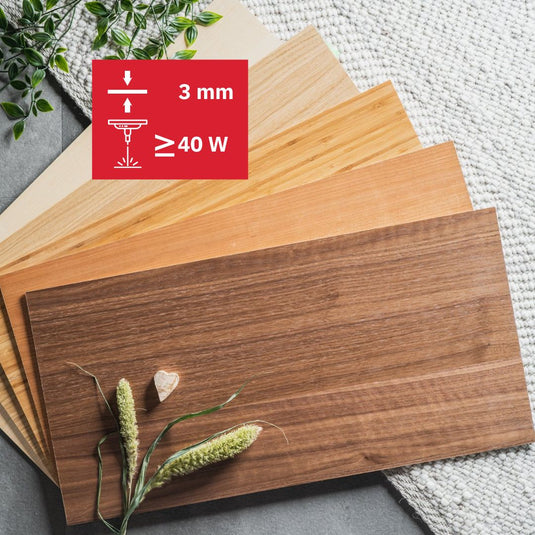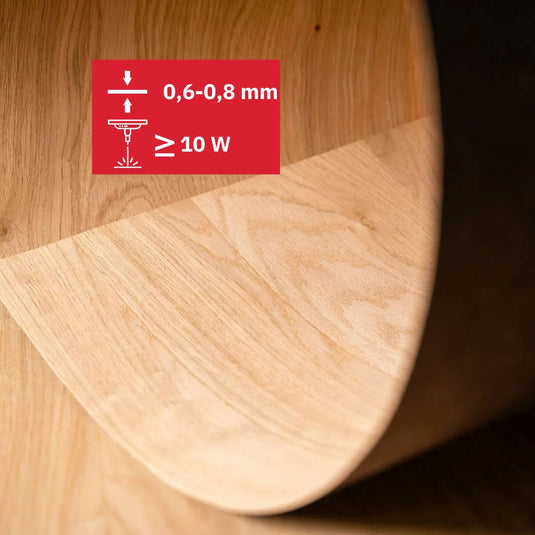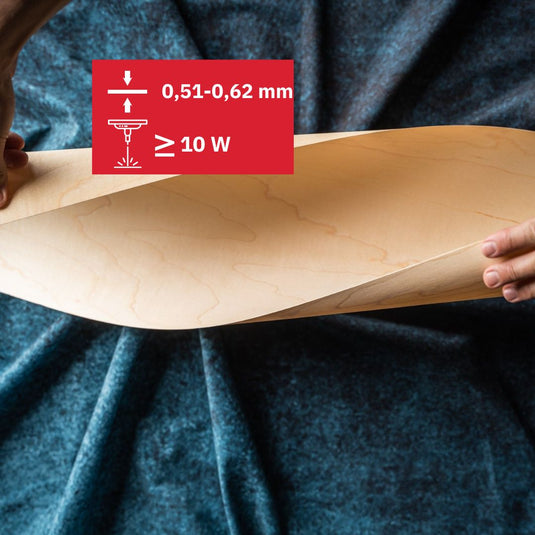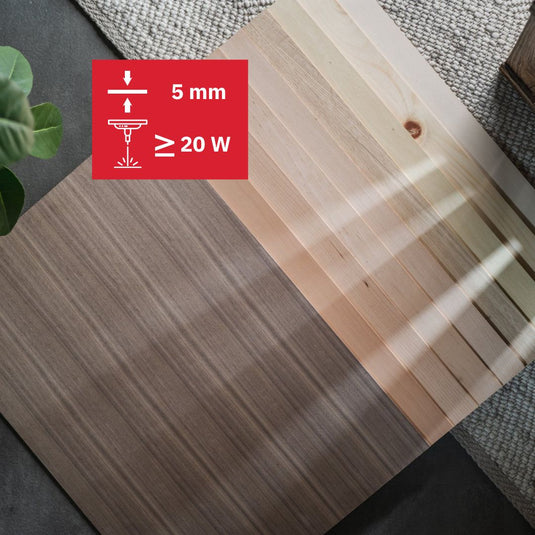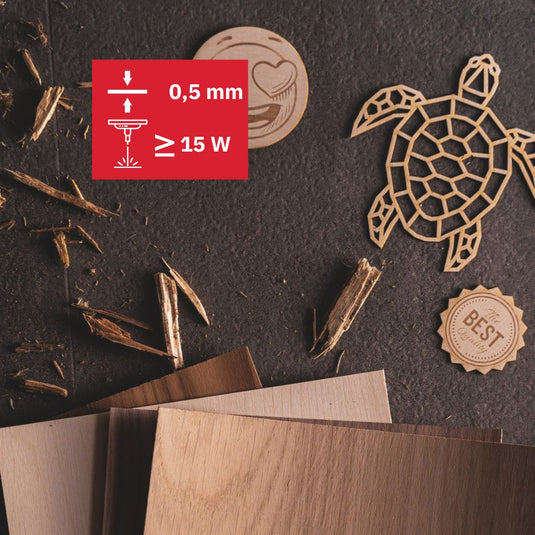Thin wood panels: Properties, applications, and advantages in laser processing
Thin wood panels are an indispensable material in many craft and industrial fields. Whether for model making, furniture pieces, or decorative elements – these light and flexible panels offer a variety of applications. They play a significant role especially in laser processing, as they can be processed precisely and efficiently due to their low thickness. But what exactly are thin wood panels, what types are there, and what advantages do they offer in laser processing?
What are thin wood panels?
Thin wood panels are wood materials with a low material thickness, typically in the range of 1 to 6 mm. They consist either of solid wood, wood layers (as in Plywood), or compressed wood fibers (as in HDF). Due to their thin nature, they are particularly light and flexible, making them attractive in many areas.
The most common types of thin wood panels are:
- Birch Plywood and Poplar Plywood: Multilayer panels made of birch or poplar wood, known for their stability and at the same time low thickness.
- Raw HDF and Precious HDF: Highly compressed fiberboards with a very smooth surface, also available with Veneer paper.
- SmoothyPly: A very smooth, thin Plywood ideal for fine work.
- Precious Uniply: Consists of two glued Veneer papers, giving it special flexibility and lightness.
Typical applications of thin wood panels
Thin wood panels are used in many areas, especially where precision and lightness are required. The most common application areas include:
- Model making: The thin panels are excellent for building architectural models, miniature vehicles, or aircraft models because they are easy to work with and allow precise cuts.
- Furniture design: Thin wood panels are used for decorative elements or delicate details in furniture because they are easy to shape and process.
- Interior design and decoration: Thin panels are used in the design of wall coverings, decorative panels, or ornaments.
- Art and craft: Artists and craftsmen use thin wood panels to realize intricate designs, e.g., through laser cuts or engravings.

Advantages of thin wood panels in laser processing
The laser processing has established itself as one of the most efficient methods for processing wood panels. Especially thin wood panels offer some decisive advantages here:
- Precision and speed
Thanks to their low material thickness, thin wood panels can be cut particularly quickly and precisely with the laser. The laser has to penetrate less material, which significantly shortens processing time and enables extremely fine detail accuracy. This is especially advantageous for delicate projects such as jewelry, model making, or decorative patterns.
- Clean cut edges
Thin wood panels have particularly clean cut edges during laser processing. Since less heat is needed to penetrate the material, the risk of discolorations or charring at the cut edges is minimal. This reduces the need for post-processing and ensures a professional surface.
- Less material deformation
When laser processing thicker wood panels, strong heat exposure can cause deformations or cracks. Thin wood panels are significantly less sensitive in this regard because they absorb less heat due to their low thickness. The material remains stable and hardly deforms, which is very important for precise work such as engravings or cuts.
- Energy and cost efficiency
Since thin wood panels can be cut faster and with less energy, they are not only time-saving but also cost-efficient. This applies both to the laser's energy consumption and to material usage. Thinner panels are often cheaper to purchase and easier to process, making them an economical choice for many projects.
- Flexibility in design and processing
Thin wood panels can be easily bent and shaped, making them especially suitable for creative and unusual designs. Laser cuts can create precise contours, patterns, or engravings in the material. Veneered variants such as Precious HDF or Precious Uniply additionally offer an aesthetically appealing surface, ideal for high-quality decorative objects.
Disadvantages of thin wood panels
Despite their many advantages, there are also some limitations to consider when using thin wood panels:
- Low stability: Thin panels naturally offer less strength and stability than thicker materials. They are therefore not suitable for load-bearing constructions or mechanically stressed applications.
- Heat sensitivity: With extremely thin materials, such as Veneer paper or Precious Uniply, the laser can quickly cause burns if not set properly. It is therefore important to precisely adjust the laser to the respective panel thickness.

Conclusion: Why thin wood panels are ideal for laser processing
Thin wood panels are ideal for laser processing due to their easy handling, flexibility, and clean results. Whether for fine engravings, quick cuts, or creative projects – their precision and speed in processing make them a popular material in many areas. Despite some limitations, they offer a variety of applications, from decorative furniture parts to detailed model components. The choice of the right material ultimately depends on the specific project, but especially in laser processing, thin wood panels prove to be an excellent choice.

